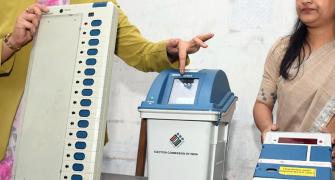In 2001, private Indian manufacturers were first allowed into the defence sector, subject to licences.
Since then, private industries, as well as the government's licensing authority, have faced a conundrum: Nowhere did the government lay out what constituted 'defence equipment.'
In many cases, there is no ambiguity. Warships, fighters, tanks and machine guns are clearly defence equipment. The confusion lies where an item has both military and civilian usage.
Explosives like gelatine are extensively used in road construction; radio sets are used by the police, security guards, civilian corporations; software, with its flexible applications, is even more difficult to categorise as either 'civilian' or 'military.'
The Defence Procurement Policy of 2008, unveiled on August 1 by Defence Minister AK Antony, tries for the first time to lay down a list of defence products. A single page annexure (Annexure VI to Appendix D of DPP-2008) specifies 13 generic categories that will be treated as defence products for offset purposes.
This list reflects the work of a Ministry of Defence committee, headed by former Additional Secretary of Defence P K Rastogi. But there is no attempt at comprehensively defining defence products.
The list confines itself to broad categories like 'vessels of war, special naval systems, equipment and accessories' and 'high velocity kinetic energetic weapons systems and related equipment.'
While India has moved incrementally towards greater transparency in sensitive items, defence has remained opaque. In 2004, the Director General of Foreign Trade had published the Special Chemicals, Organisms, Materials, Equipment and Technologies List. This includes sensitive items related to Nuclear, Biological and Chemical warfare, special materials, stealth technologies, aeronautics and rocket materials.
But the SCOMET List remained silent on 'defence products.' The list contains seven categories (eg Category 0: Nuclear materials, Category 1: Toxic chemicals and so on), each of them spelling out in minute detail the items that would fall within it. But Category 6, earmarked for defence products, remained blank, listed as 'Reserved.' Now DPP-2008's list of defence products will fill that.
Other countries, however, define their defence products more explicitly. The US defines a comprehensive 'Munitions List' under the International Traffic in Arms Regulations.
In contrast to India's generic mention of 'energetic materials, explosives, propellants and pyrotechnics,' the US list names all the explosives it considers of military grade; it specifies other explosives 'with a detonation velocity exceeding 8,700 metres/ second at maximum density or detonation pressure exceeding 340 kilobars.'
Senior MoD officials say India's new list of defence products is guided by the Wassenaar Agreement, a 40-country agreement (of which India is not a part) that seeks to bring about greater transparency in the international transfer of military and dual-use goods.
India had earlier been nudged towards greater transparency in the nuclear field. In July 2005, India had comprehensively updated Category 0 of the SCOMET List -- which spells out nuclear materials -- after passing the Weapons of Mass Destruction and their Delivery Systems (Prohibition of Unlawful Activities Act), 2005. This was one of the pre-conditions laid down by Washington in order to take forward the US-India nuclear deal.








